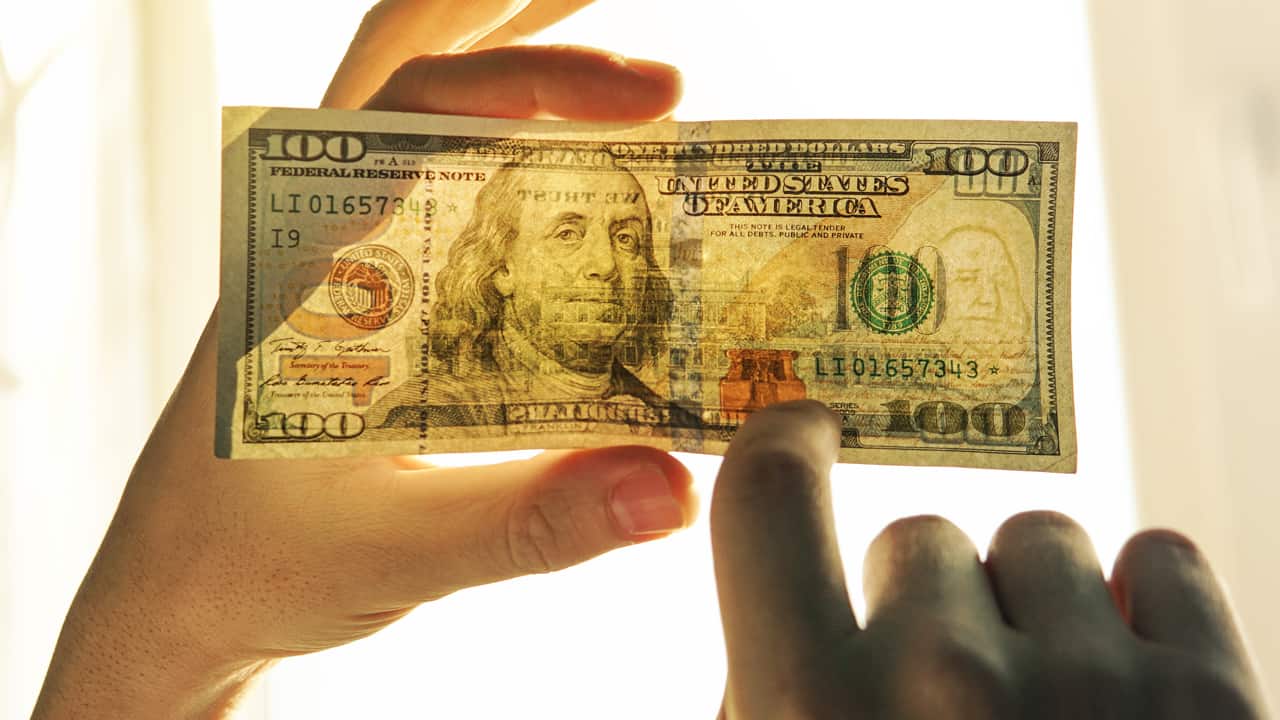While ultraviolet (UV) counterfeit detection lamps and counterfeit money pens can be useful, there are additional methods that can be used to determine if a bill is genuine or not. Banknote ink, watermarks, and text are all there for a reason. they are all part of a carefully designed security system to ensure that only real money is exchanged.
Learning to identify a counterfeit $100 bill can save a corporation thousands of dollars in losses. With the advent of so many counterfeit money for sale online it is necessary to know the authenticity of the bill, here are eight ways to do it.
1. Ink That Changes Colors
Verifying the denomination in the lower right corner of a bill for color-changing ink is a good initial step in determining whether or not a bill is genuine. All banknotes issued in the United States with a face value of $5 or higher since 1996 have included this security feature. If you hold a bill from the new series (other than the new $5 bill) and tilt it from side to side, you’ll notice that the number in the bottom right corner changes colour from green to black or gold.
2. Watermark
Genuine banknotes always have the distinctive security feature of a watermark. The watermark on many modern bills is an exact duplicate of the bill’s portrait. If you look closely, you can see an oval here, although on other bills it is just a spot. Here are a few things to remember while examining a bill’s watermark:
- Holding the bill to the light is the only way to see the watermark.
- The watermark must appear on the right side of the currency.
- If the watermark is a person’s face, it must be an exact duplicate of the one on the bill. The face and watermark may not match if the bills were counterfeited by bleaching lesser values and reprinting them with higher values.
- The bill is almost certainly counterfeit if it either does not have a watermark or the watermark is not visible unless held to the light.
3. Jagged edges, smudged ink, or unreadable text
Blurred borders, lettering, or writing on a bill is a telltale sign that it is a fake. Die-cut printing plates are used to produce the ultra-fine lines characteristic of genuine banknotes, giving them a look of incredible precision. In general, counterfeit printers can’t produce the same level of realism. Check the bill carefully for any smudged areas, paying specific attention to the edges. Microprinting, or extremely fine printing, is another indicator that a banknote is genuine. If the microprinting cannot be read, not even with a magnifying glass, then it is likely to be a fake.
4. Embossed Printing
Banknotes that are genuine all feature raised printing that is difficult to replicate by forgers. Carefully running your fingertip down the note will reveal any raised printing. If the raised printing is done properly, you should feel a slight vibration on your nail from it. You should double-check the bill if you don’t feel this roughness.
5. Microprinted Security Thread
A banknote’s security thread is a narrow embedded strip that runs vertically across the face of the bill. The security strip may be found to the right of the portrait on the $10 and $50 notes, and to the left of the portrait on the $5, $20, and $100 bills.
Microprinting in the security thread is an extra precaution taken by legitimate invoices. Here is a list of some of the phrases that can be found in the tiny print of real bills:
- The words “USA FIVE” appear on every five dollar bill.
- The words “USA TEN” can be found on every ten dollar bill.
- The words “USA TWENTY” can be found on every $20 bill.
- The “USA 50” slogan appears on every fifty dollar bill.
- The “USA 100” slogan appears on every one hundred dollar bill.
6. UV Radiation
UV light is used in counterfeit detection devices and technology because it is a definitive technique to identify a fake currency. Under ultraviolet light, the security thread on real banknotes emits the following hues:
It’s worth noting that the $5 bill emits a bluish light.
- The orange light on the $10 banknote
- The green light on the back of a $20 banknote
- The $50 bill gives off a bright yellow glow.
- Red and pink light emanates from a $100 bill
7. Yarns in Red and Blue
You can tell a real bill is genuine by looking at the tiny red and blue threads that are interwoven throughout the bill’s construction. Counterfeiters try to fool people with their banknotes by printing a pattern of red and blue threads on them, but if you look closely, you’ll discover that it’s just a surface level printing.
8. Serial Numbers
The serial number is the last item you should check on a bill. The first letter of the serial number on a bill is tied to the year it was printed; if it does not correspond to the year on the bill, the bill is fake. Here is a list of years that correspond to each letter:
• E = 2004
• G = 2004A
• I = 2006
• J = 2009
• L = 2009A
These safeguards weren’t merely put in place to prevent criminals from forging currency, but also to aid the general public and legitimate businesses in spotting fake bills. To avoid being held accountable for any losses and to let the Federal Reserve know about counterfeit bills in circulation, you should report any bill with even the slightest suspicion of being fake to the U.S. Currency Education Program.



